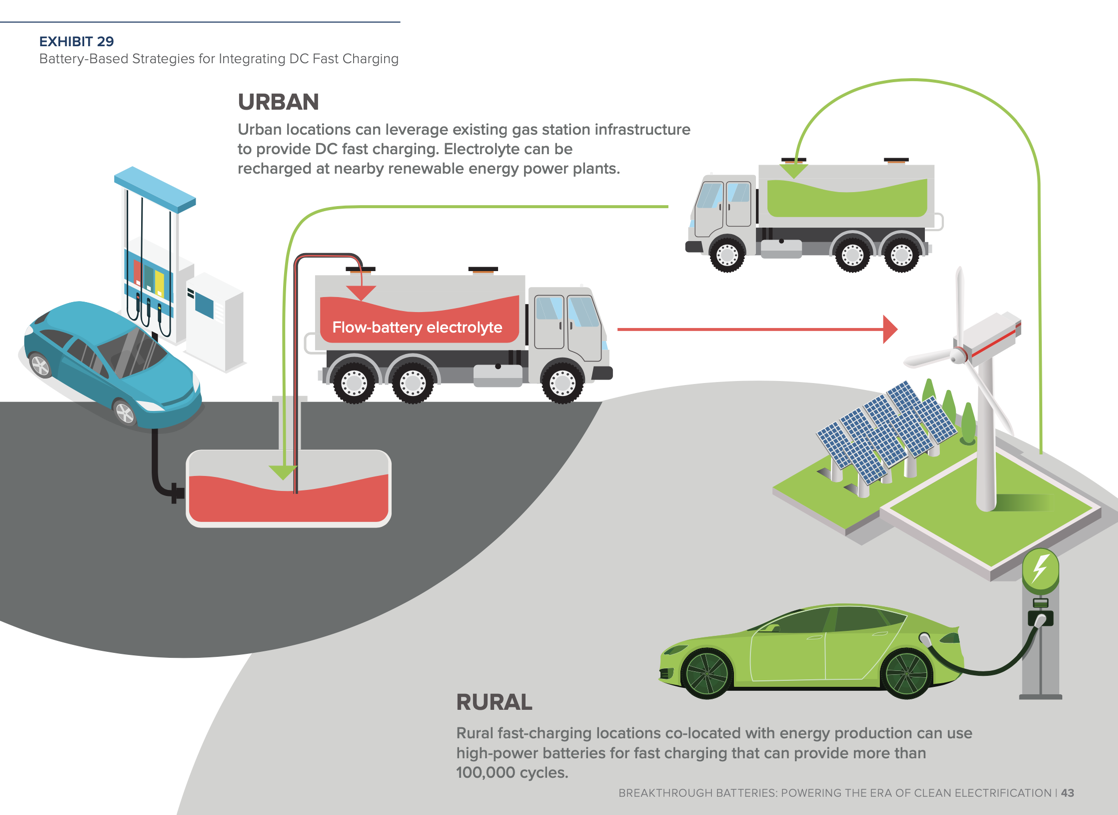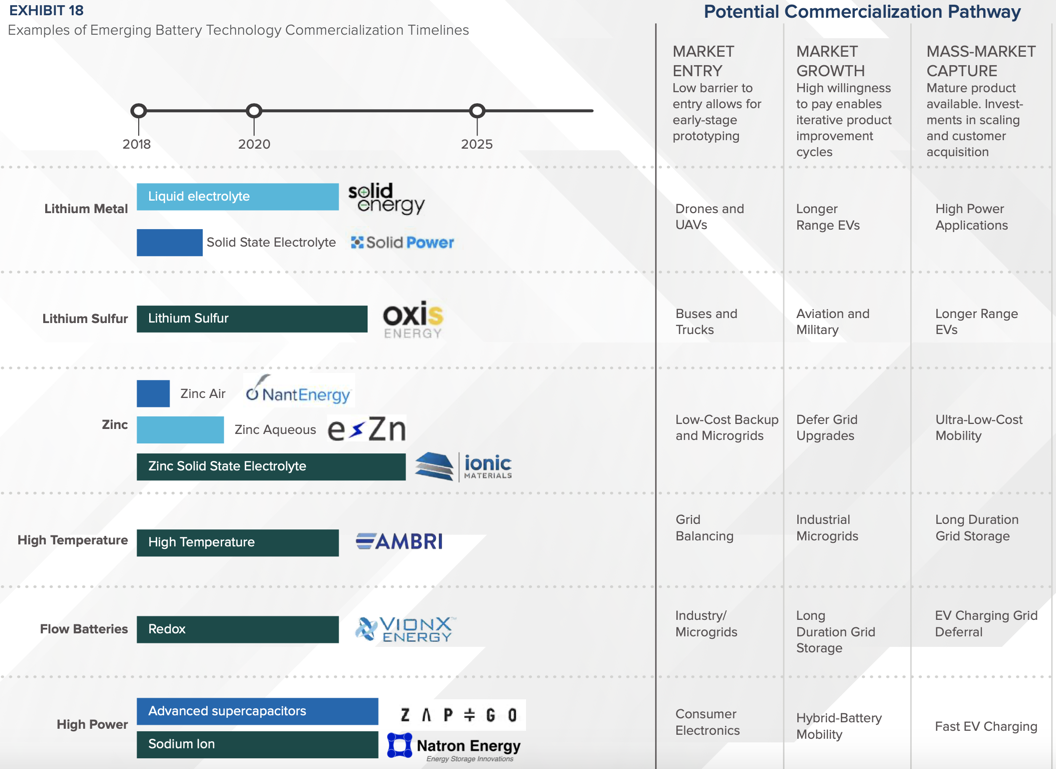
Does the rapid pace of battery technology mean game over for gas will be sooner than expected?
Governments’ flailing support for fossil fuels was handed another card marked “are you nuts?” last week, with the Rocky Mountain Institute releasing a report saying renewables plus batteries are already cheaper than new gas plants, and will be cheaper than existing gas plants in the mid-2020s.
Regulators and policy-makers almost certainly haven’t kept up with the pace of change, the Institute’s Breakthrough Batteries: Powering the Era of Clean Electrification report claimed.
The cost of energy storage is falling so fast, it’s going to disrupt utilities’ “conventional assumptions” about grid architecture.
“Utilities and their regulators must build scenarios based on forward price curves to assess the possible implications of falling prices for batteries and renewable power in order to minimise the risks of investing in assets that could soon be stranded.”
The Institute reckons big players in the power market have been blindsided by the way battery costs are plummeting, and by the accelerating development of new energy storage technologies.
The fast pace of battery adoption is also going to increasingly push internal combustion engines off the road, the RMI paper said (linked at this media release).
The high points are pretty outstanding, to be honest: there was more than US$1.4 billion invested in battery technology in the first half of this year, and that’s going to grow at a stunning rate.
“Total manufacturing investment, both previous and planned until 2023, represents around $150 billion dollars, or close to $20 for every person in the world”, the report stated, citing Bloomberg New Energy Finance data.
Lithium ion will keep its crown as the leading battery technology RMI says, with advances flowing both from R&D in the technology and improvements in manufacturing.
Even now, with Li-ion storage costing over $US200 per kWh (page 76 of the report), RMI says renewable-plus-battery builds are “contributing to cancellations of planned natural gas power generation”.
Gas will become a stranded asset very rapidly if RMI is right, because by 2025 it expects Li-ion costs to fall to $US87/kWh.
“Natural gas plants that move forward are at high risk of becoming stranded assets, and as early as 2021, some existing power plants could be more expensive to continue operating than least-cost CEP (clean energy portfolio) alternatives”, the report said.
Disruptive Chemistry
While the report puts Li-ion in the box seat, other technologies will have their place:
“Solid-state batteries such as rechargeable zinc alkaline, Li-metal, and Li-sulfur will help electrify. Dramatically lower storage costs will disrupt conventional assumptions about optimal grid architectures and open a rapidly widening array of opportunities for delivering energy services. Utilities and their regulators must build scenarios based on forward price curves to assess the possible implications of falling prices for batteries and renewable power in order to minimize the risks of investing in assets that could soon be stranded.”
“Low-cost and long-duration batteries such as zinc-based, flow, and high-temperature technologies will be well suited to provide grid balancing in a high-renewable and EV future.”
“High-power batteries, which are best compared on a $/kW basis, are well positioned to enable high penetration and fast charging of EVs.”
EVs Also Winners
The electric vehicle market is going to experience a similar disruption (the sooner the better!), both from Li-ion developments as well as new chemistries.
RMI believes India is set to race ahead in EV adoption because its market is skewed towards smaller (and even three-wheeler) vehicles. That’s already happening in some parts of the Indian market – this World Economic Forum article outlines the electrification of India’s vehicle fleet with government support, and taxi company Ola has a “Mission:Electric” project to integrate 10,000 electric rickshaws into its fleet.
The Institute believes there will be more EVs sold in 2025 worldwide than currently exist, with a corresponding jump in charging infrastructure to more than 10 million charging stations worldwide by 2030. The report also notes there’s going to be a feedback loop into grid batteries, since batteries installed near EV charging stations will help mitigate any strain they might cause the grid.

EVs and batteries, a virtuous circle. Source: Rocky Mountain Institute, Breakthrough Batteries pg 43
The report’s assessment of important future technologies is below.

RMI’s assessment of future battery chemistries. Image: Rocky Mountain Institute, Breakthrough Batteries, Page 31.
If RMI is correct, then Australia’s state and federal governments’ enthusiastic embrace of fossil fuels has to end, because otherwise public finances will be shackled to stranded assets the rest of the energy market is going to ignore.

 RSS - Posts
RSS - Posts



Can someone please advise me where you can buy Li-ion storage costing anywhere near the $US200 per kWh stated in the report?
First you have to build a $2Billion dollar battery factory and then you need to use that factories full output for a decade or more.
Both Volvo and Tesla say the cost of their battery cells are now around $100 US per kilowatt-hour. That’s a hell of a drop of price and comparable to the fall in the cost of PV. There’s definitely more to creating an energy storage system than just the cells, but the cost of that is not going to be prohibitive when done on a large scale, as is being done now.
We’d need to buy a grid-scale battery for a chance at the US$200 (A$290) per kWh price. Retail prices here were still around A$1200 to $1400 per kWh when I last heard.
I have yet to see any retail price reduction of any substance. With batteries appallingly overpriced for the value they provide, adoption rates cannot yet climb to enable price reductions due to economies of scale.
Perhaps when the off-grid-by-necessity market is saturated, prices will be pushed down, at least if sales are to be made.
Fantasyland. (say G’day to Mickey Mouse for me.)
For those wondering who the hell is Rocky Mountain Institute and what do they do?:
“RMI transforms global energy use to create a clean, prosperous, and secure low-carbon future”
So it has to be noted they do have a vested interest in this report. However they are a major consultancy who advise cities and municipalities on de-carbonisation strategies. So they would be across a lot of facts and figures. But of course they are never going to produce a report that would harm their business model.
It’s not that I don’t agree with the report and champion it’s conclusions (I do disagree with the contention that existing fuel stations will have charged electrolyte shipped too and from their location by trucks – that makes absolutely zero sense? Especially economically which is what RMI are supposed to be good at.) I do want to make sure we check facts and don’t leave ourselves open to the same kind of criticism that is often levelled at the fossil fuel industry – ie totally biased reports and papers. All such papers should be peer reviewed for accuracy. And I hardly think Scott Morrison and his chums in Canberra are going to pay any attention to this report – they’ll just blow it off as another renewable scam.
“Trucking in electrolyte”?
My brain has to bend over backwards to think of a situation where that might make sense.
If I could buy Li-ion at US$200 per kWh, I’d immediately go off-grid.
Don’t think I’ll be doing that any time soon.
I understand that an aluminium/air battery has been developed in the UK, which is basically a ‘onetime use’ but which could power a car for 1500 miles and then be simply and quickly replaced with a new one. The old one could then be recycled and reused. A friend has suggested that such a battery could easily power the lights and other appliances when the solar is not working at night. Knowing nothing about the subject, but a keen supporter of electric cars having experience many different ones in China for the past few months, can you comment on the concept of the battery and it’s possible uses?
Hi Brian, Ronald here.
The aluminium/air battery has been around for a long time. The main drawback is it’s going to be more expensive to operate than a lithium ion battery. A major reason is because they are far less efficient than lithium batteries. I’d have to check the chemistry, but it takes something like 4 kilowatt-hours of electrical energy to produce enough alumimium to provide 1 kilowatt-hour of stored battery electricity. (This applies even if the aluminium oxide produce by the battery is recycled.) They could still have some uses. For example, it has been suggested they could be used for electric flight, as they start light and get heavier as they are used.
Thank you for your reply. As a complete ignoramus when it comes to electricity, I was interested to see the metalectrique.com website and also the Phinergy site where both seemed to me to suggest that the air/aluminium battery was both smaller and able to hold a much greater charge – hence driving a car for 1500 miles and then simply swapping the battery for another. Such a battery capacity would be very useful for times when solar is unavailable I would have thought. I gather it is relatively light and small – ideal for the home, and when used you simply exchange as I understand it cannot be re-charged. To change in a car is a matter of minutes apparently. There are numerous other advantages, such as not needing recharge points and a swap could be made at a supermarket apparently.
Brian – I think Ron explained it well. They’re too expensive. Petrol currently costs around $1.50 pl so to do $1500 kms in an economy vehicle costs $AU175. Let’s be generous and say $250 if you’re a lead-foot in an SUV. An EV costs between $30 and $110 depending @ what rate you buy your power. An Aluminium Air battery that will run a vehicle for 1500 kms would be over $US6,214 based on a model 3 (@$US 29kWh which is the projected price if they are mass produced). It doesn’t make a lot of sense. Plus you then have the problem they are incredibly inefficient when it comes to making them.
I think they’ll be edge cases at best – as Ron pointed out, electric flight where weight is critical.
Daimler has promised to bring out Solid State batteries within 2 years in their commercial EVs – we’ll see, but they seem more promising.
i wouldn’t get too excited about the growth in EV take-up in India just yet
According to this news article on the ABC, India’s capital city – New Delhi – had an Air Quality Index (AQI) of over 900 just yesterday, a level of atmospheric pollution classifed as ‘unbearable’ (see https://www.abc.net.au/news/2019-11-04/indias-capital-new-dehli-reaches-unbearable-levels-of-pollution/11668054 ).
The level rose even higher on the 5th November, according to this Washington Post article: https://www.washingtonpost.com/world/indias-losing-battle-against-pollution-delhi-air-quality-reaches-toxic-levels-again/2019/11/04/0901f378-fecc-11e9-8341-cc3dce52e7de_story.html
By way of comparison, Sydney’s AQI – which has been pushed up by smoke from bush-fires and dust blown in by strong winds – had an AQI of 36 yesterday. Looking at it another way, New Delhi’s atmospheric pollution was 25 times more polluted than Sydney.
I doubt 10,000 rickshaws powered with electric motors, in a city with a population of some 40 million ( which was by the way reduced by some 1.7 million in 2017 due to a early deaths caused by even higher pollution in late 2016 when the AQI reached 990 ), is going to make much difference now.
The point I want to make though, is that New Delhi is a prime example of how bad things can get if you don’t do enough to address problems while they are still manageable. Leave it too long and a ‘problem’ can start having a life of its own, spawning all kinds of unexpected consequences and flow-on effects which can then all coalesce together into a nightmarish situation.
We’ve already gathered together some of the necessary ingredients for that to occur here in Australia:
: despite the fact that some 77% of the entire Australian population is concerned about both climate change and potential food shortages, (thats the average across all age groups) only a few politicians at the Federal level seem to have taken any notice. see both : https://www.abc.net.au/news/2016-09-26/77pc-of-australians-believe-climate-change-occurring-survey-says/7876416
and also: https://www.abc.net.au/news/science/2019-09-10/climate-of-nation-australia-attitudes/11484690
An earlier 2016 survey indicated that 80% of farmers wanted the Federal Government to do more to address climate change. As yet, they are still waiting for that to happen. Some belated action has been taken to build dams in country towns. I say ‘belated’ because some of the projects have already been around for years awaiting Federal funding .
: coal mining issues still unresolved – here’s a recent example relating to the Maules Creek coal-mine in NSW, and allegations of illegal use of ground-water – see: https://www.abc.net.au/news/2019-11-05/maules-creek-coal-mine-under-investigation-again-over-water-use/11658718
This mining incident is quite relevant to the food shortage issue – farmers in the local area are alleging that the mine operator’s diversion of ground-water (for which it has been convicted previously) has meant they no longer have sufficient water supply for their crops.
A comparable example is the Adani project. The project requires the diversion of 1.25 billion litres a year from a river, and this affects farmers in the region. See: https://www.abc.net.au/news/2018-11-07/adani-water-project-bypassed-full-assessment-against-advice/10457670
I have yet to see any real signs of commonsense in the area of climate change at a Federal Government level, nor do I think it likely that we will between now and the next election. That’s currently due in 2022 unless something happens to trigger an earlier one.
I think the point was the Indian Govt is doing much more than Australia on the EV front.
New Delhi has a population density of about 7000 more people per sq km than Sydney or about 18 times higher. New Delhi is also no where near the coast so does not get a prevailing sea breeze like Sydney.
The point is – they just aren’t comparable. Vehicles only account for about 9% of air pollution, so even if you completely eliminated vehicle emissions there’s still power. India is doing much more than Australia on the renewable energy front. But of course the scale is much larger. 1,517 TWh pa compared to Australia’s 190 odd TWh and it’s still 55% coal driven and 7% Gas.
I don’t know where you got the ‘9% of air pollution’ figure from Mondo, one figure I saw indicated that vehicle fumes contributed 52% of the overall pollution level, while another suggested that vehicles accounted for 30%
The problem is that there are a large number of factors involved, such as seasonal weather changes during the year, the extent of monsoonal rains (rainfall tends to clean the air somewhat, the level of building and road construction activity, open fires used for cooking and heating in winter etc etc.
This 2018 article from the Indian Centre for Policy Research which I found at : https://www.cprindia.org/news/6802 gives a good outline of the issues surrounding vehicles in New Delhi. Chief among them are – old vehicles that burn fuel inefficiently, inadequate fuel standards because India has been slow to move towards ‘cleaner’ fuels, and a huge growth in ‘urban delivery’ vehicles in recent years due to the increase of e-commerce.
It is true that the Indian Government is trying much harder than it was say 5 to 10 years ago, but it now needs to be ultra careful about avoiding unintended major ‘disruptive’ effects caused by hasty change, otherwise things could well end up worse overall for it’s citizens in other and quite unexpected areas of activity.
Political factors (both internal and external) also have a significant influence as well on India’s spending priorities.
However, I still maintain that India serves as a real world illustration of what a ‘worst case’ scenario might begin to look like on a global scale if governments everywhere continue to place too low a low priority on climate change and ‘environmental remediation’ spending. Obviously the effects will differ – probably dramatically so – in their detail at different locations.